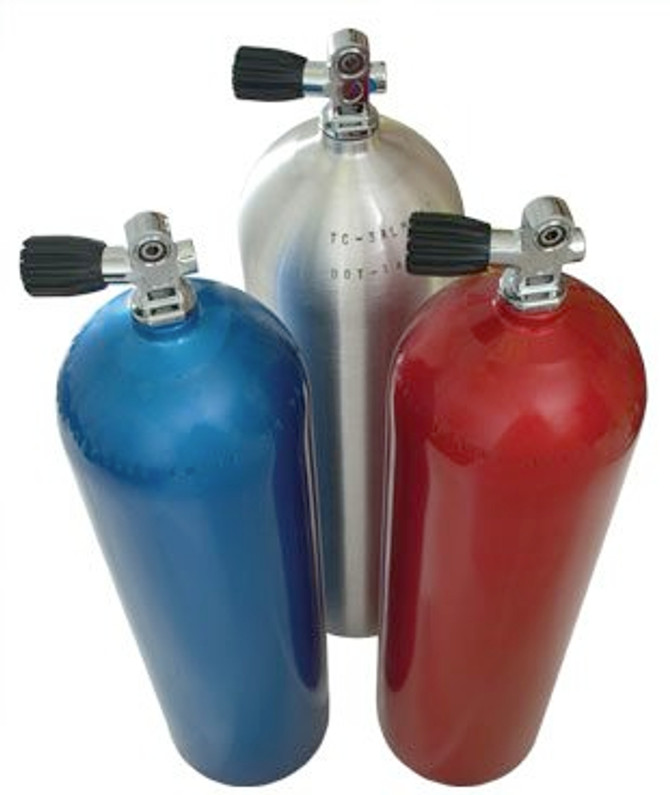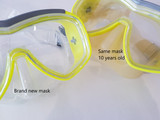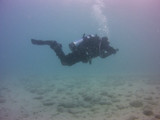Choosing a Scuba Tank - Things to Consider
Selecting a scuba tank, also referred to as scuba cylinder, is about as personal as buying new underwear. The same one doesn't fit every person, no matter how hard you try. There are a lot of factors to consider when purchasing a scuba tank. So the next time another diver says, "well I dive with XYZ tank" the next thing you should ask is "why?" because the reasons they dive that particular size and type of tank are personal to them and may not be suitable for you.
A few years ago I tried a dive with a completely different size and type of tank. I experienced what I like to call the "dog-paddle-turtle" effect. Imagine you're diving and looking to the side for your dive buddy. Then having to literally dog paddle your body back around to avoid ending up on your back like a beached turtle. That's what diving this different size tank was like for me. It was too short and heavy for me to handle in the water (yeah, I'm a wimp). I'm not going to tell you which tank it was, because for me, this was not a suitable tank. But it may be perfectly suitable for you or another diver.
TYPES OF TANKS
Scuba tanks are manufactured from either steel or aluminum. Both types have different characteristics that may make one more appealing to a diver compared to the other. Steel is stronger and more ductile compared to aluminum. If you were to cut a tank in half, you would see the walls of the steel tank are much thinner compared to the very thick-walled aluminum tanks.
Aluminum tanks are susceptible to damage from extreme heat, over 350 degrees F, for example with heat-cure painting. With extreme heat, tank walls lose their strength and may fail at normal service pressure. Aluminum tanks are also a bit more fragile in that it is easier to cause dings and nicks which may cause the tank to fail a visual inspection.
Steel tanks used to be significantly more expensive than aluminum tanks. But it seems over the past few years the price gap has decreased. The price difference between steel & aluminum tanks is very small and probably won't play as much a role when choosing which tank to purchase.
There are few different manufacturers of scuba tanks in North America. They include Luxfer, Catalina, and Worthington. The name of the manufacturer will be stamped on the neck of the tank (see bottom of article).
CAPACITY - HOW MUCH AIR IS IN THE TANK
There is a wide variety of scuba tanks that hold varying capacities of air. Tanks are named according to the capacity of air that they hold at maximum service pressure. For example, the "aluminum 80" holds approximately 80 cubic feet of air. If you can imagine a telephone booth (or a porta-potty if you're too young to know what a telephone booth is), that is approximately 80 cubic feet. This is the amount of air that is compressed into the scuba tank.
Several scuba tanks hold a different capacity than the size used to describe them. The aluminum 80 has an actual capacity of 77.4 cubic feet whereas the steel 77 is 77.1 cubic feet. So even though the aluminum 80 sounds bigger, and therefore would have more air, they actually hold a similar amount of air.
PRESSURE - DOES NOT MEAN HOW MUCH AIR IS IN THE TANK
THE AMOUNT OF AIR YOU WILL HAVE TO BREATHE DURING THE DIVE HAS NOTHING, I repeat, NOTHING, TO DO WITH THE PRESSURE RATING!! This is by far the biggest misunderstanding when it comes to scuba tanks. Divers can't keep up with their virtually non-breathing dive buddies and they think they need the highest pressure tank to keep up. Well, that's not correct. Let me explain.
One of the smallest scuba tanks is the aluminum 6 which holds about 6 cubic feet of air. The pressure rating on this tank is 3000 psi. That means when the tank pressure is 3000 psi there is approximately 6 cubic feet of air ready for a diver to breathe. The most popular tank is the aluminum 80 which holds approximately 77.4 cubic feet of air. The pressure rating on this tank is also 3000 psi. That means when the tank pressure is 3000 psi there is approximately 77.4 cubic feet of air ready for the diver to breathe. So which tank would you like to take on your next dive? The one with approximately the same amount of air as a telephone booth or the one with the same amount of air as your kitchen oven? (yeah, I measured!)
Every tank will have a pressure rating but many tanks of different capacities will have the same pressure rating. The pressure rating indicates the pressure the air is at inside the tank when the tank is at full capacity. There are a variety of pressure ratings which include low pressure (2000-2400 psi), standard pressure (3000 psi), and high pressure (3300-3500 psi).
Some steel tanks will have a pressure rating with a plus sign, for example 2400+. This means that the tank can be filled 10% over the stated pressure. So instead of 2400 psi, the tank can be filled to 2640 psi, equal to 188 bar (metric) which is also stamped on the steel tank. So why don't they just stamp 2640 on the tank instead? Good question, perhaps I will explore that in a future article.
High pressure steel tanks are usually a bit smaller and more compact compared to their low pressure counterparts which may be appealing to some divers. Because they require a higher pressure (3300-3500 psi) to be "full" it can be difficult to get a good fill. The higher the pressure, the closer the air molecules are compressed and the hotter the air will get. A tank can get very hot to the touch while being filled to the maximum pressure. Once the tank cools off, the air molecules cool and the pressure in the tank will drop. For example, with a high pressure steel 80 tank, if it has less than its service pressure of 3442 psi once it has cooled, you will have less than 80 cubic feet of air in the tank. Getting a good, full fill on a high pressure tank is very difficult. This is one drawback of a high pressure scuba tank.
BUOYANCY
The type of tank that you dive with will affect your buoyancy as well. If your tank is too long for your body type, you might find you're hitting your head on the valve and kicking the bottom with your heels. If the tank is too short and heavy, you might feel the same "dog-paddle-turtle" effect that I felt.
There is also a difference in the buoyancy between tanks, especially steel & aluminum. For example, the popular aluminum 80 is negatively buoyant at the start of the dive when the tank is full, but actually becomes positively buoyant at the end when the tank is close to empty. Imagine doing your safety stop and someone hands you a balloon to hang on to. The effects of the tank becoming positively buoyant can make it difficult to stay down near the end of your dive. So you may need to add more weight at the start of the dive to ensure you are able to stay down at the end of the dive.
Alternatively, a steel tank starts negatively buoyant and remains negatively buoyant even when empty. In other words, nobody will be handing you a balloon on your safety stop. You will probably need less weight compared to the aluminum tank simply because you won't have it pulling you up at the end of the dive. Needing less weight is appealing for both warm and cold water diving. But for cold water diving in Canada where some divers need 30, 40, or more pounds of lead to counteract thicker wetsuits and drysuits, a steel tank may be favorable for that reason alone.
OTHER THINGS TO THINK ABOUT
If you remember from you open water class, the deeper you dive, the faster you will breathe your tank down. Because the air you are breathing is compressed at depth, you will need more of it to fill up your lungs with every breathe you take.
So to keep up with your super-air-breathing dive buddy, you MAY need a tank that is a bigger capacity, not necessarily a higher pressure. But before you run out and buy a 130 cubic foot tank, also keep in mind other considerations.
For example, would you still be within your no-decompression limits with the larger tank or would you come back with your tank half full. Some divers, especially in cold water, are either cold or tired before they reach their no-decompression limit or even breathe their tank down.
Also consider whether a larger tank is suited for your physical size. You might be overwhelmed by the size of the tank, like I was, and wear yourself out trying to maintain good buoyancy, which in turn will cause you to breathe harder and use your air faster.
A bigger, heavier tank may overweight you as well. In warm water, an aluminum 80 with my aluminum 19 pony bottle allows me to wear only 4 pounds of weight. A bigger, heavier tank would probably cause me to be overweighted.
Also consider that your poor air consumption could be because of a variety of other reasons not related to the size of tank you are using. Poor buoyancy control, poor kicking techniques, your physical fitness, swimming too fast, incorrect distribution of your weights, or not streamlining your gear can all cause a diver to use more air.
VIZ & HYDRO
A visual inspection, sometimes referred to as a "viz", is required every year on your scuba tank. This test is not required by law, but is an industry standard in North America. A sticker will indicate the year and month that the visual was done and the facility that performed the inspection. The inspector will take the valve off the tank, look inside the tank, and ensure it is still in good condition. Things that the inspector will look for is contamination inside the tank (like moisture or rust), cracks or pitting inside, nicks and dents on the outside of the tank, and any imperfections with the threads of the tank that may lead to tank failure. There are very specific requirements with performing a visual inspection and allowing a tank to pass the inspection. Many times during the visual inspection of a tank, serious contamination was found inside (and that is what the diver is breathing!)
A hydrostatic pressure test is required by law, every five years. A "hydro" involves pressurizing the cylinder to its test pressure (usually about 5/3 the working pressure) and measuring its volume before and after the test. A permanent increase in volume above the tolerated level means the cylinder fails the test and the scuba tank should be destroyed.
WHAT DO ALL THOSE MARKINGS MEAN
At the top of the tank just below the neck you will see engraved markings that look something like this:
CTC/DOT 3AL3000 S80 P1234567 LUXFER 9^99
What does all that jibberish mean?
CTC/DOT - Dept Transportation Canada / US Dept of Transportation
3AL - aluminum tank (AA = steel)
3000 - pressure rating
S80 - size of tank (80 cubic feet)
P1234567 - serial number
LUXFER - manufacturer name
9^99 - date of last hydrostatic test (Sept 99)
Like everything with scuba diving, choosing your scuba tank is a very personal decision. There are a lot of factors that you will need to consider. If you have the opportunity to rent and try different sizes & types of scuba tanks prior to purchase, this may be worth the effort. Seek the advice of your more experienced dive buddies. But keep in mind, with every piece of advice always ask "why" so you can decide if their reasons are a good fit for you. Remember.... you probably won't fit their underwear either!
Recent Posts
-
7 Key Features to look for in a Scuba or Snorkel Mask
One of the most important pieces of scuba or snorkel equipment is your mask. It is often the best p …2024 Oct 5th -
Sealife Sportdiver Lenses
Sealife Sportdiver housing for smartphones has been a huge hit since it was released only a few y …2024 Jul 5th -
Time to Dust Off Your Dive Gear and Get Ready for Local Dive Season!!
Depending on where you are in Canada, your local dive season could be as short as a few months. If y …2024 May 29th






